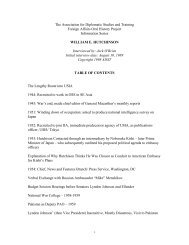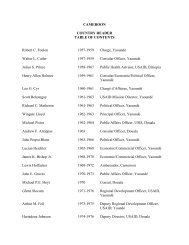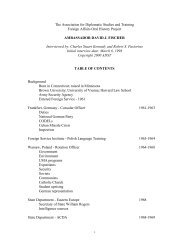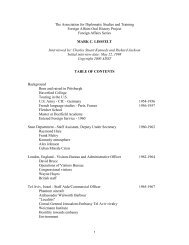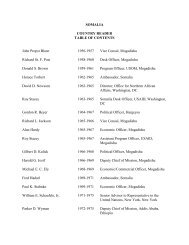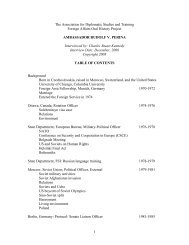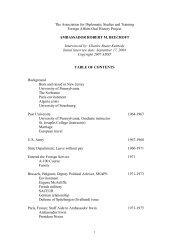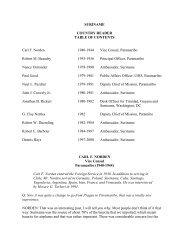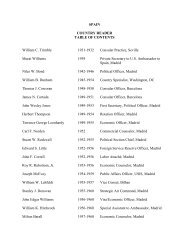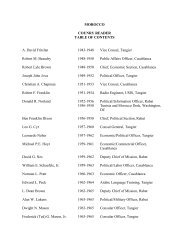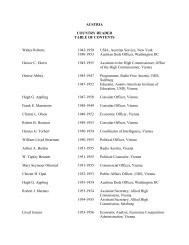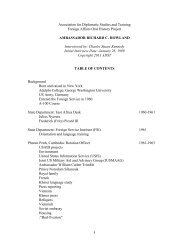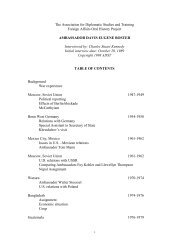1 The Association for Diplomatic Studies and Training Foreign ...
1 The Association for Diplomatic Studies and Training Foreign ...
1 The Association for Diplomatic Studies and Training Foreign ...
You also want an ePaper? Increase the reach of your titles
YUMPU automatically turns print PDFs into web optimized ePapers that Google loves.
streets. This astounded the nationalists, astounded the shah. We were somewhat shocked<br />
by it at first <strong>and</strong> then it slipped out of our political consciousness as other events took<br />
precedence, as they exiled people <strong>and</strong> cleaned out, they thought, the religious opposition.<br />
I can remember at the time, my good friend Hussein Mahdavy telling me that this was a<br />
new <strong>for</strong>ce, that we all have to take account of it.<br />
Q: What about – I realize this wasn’t your beat, but you must have been talking to other<br />
people about the army. It’s not that easy to get an army to shoot defenseless people,<br />
particularly religious people. Was the army a different breed of calf than – was it …<br />
MILLER: I think the uprising was so sudden <strong>and</strong> so violent that it seemed to the military<br />
that criminal elements were in the street. I know that the scale of the disorder was<br />
terrifying. It was premature to connect the uprising with solely the religious leaders of the<br />
country. <strong>The</strong>re were divided views about everything, <strong>and</strong> religious leaders were way<br />
down on the list of significant opposition to the Shah. Religious leaders were not at the<br />
top of the agenda; they were near the last. <strong>The</strong> clergy was the last structural organization<br />
in the political system. <strong>The</strong>re were many viable secular structures in between. First were<br />
the democratic nationalists than there were Communists, after the Communists the<br />
religious structures were of least importance, at that time, 1963.<br />
Q: And of course, putting the mob into Tehran really was going right at the jungle of the<br />
Bazaari …<br />
MILLER: Yes, loyalties.<br />
Q: <strong>The</strong>y were going to rip up the shops.<br />
MILLER: No, no. <strong>The</strong> mob wasn’t going to destroy the bazaar; after all many were from<br />
the bazaar. <strong>The</strong>y were after the shah. <strong>The</strong> bazaars, they would never touch them, because<br />
that’s where they come from. <strong>The</strong> bazaar <strong>and</strong> the religious people were <strong>and</strong> are almost an<br />
identity.<br />
Q: When you were talking to the – how long were you there after this …<br />
MILLER: This event? ’63? Two more years.<br />
Q: Was this something that was – that came to dominate the thought of the opposition?<br />
MILLER: <strong>The</strong>y thought this was a phenomenon that they had never believed could<br />
happen – it happened. <strong>The</strong>y began to take account of it. <strong>The</strong>y had religious people<br />
involved in their nationalist politics -- they always had religious people among their<br />
ranks. This was religious extremism that arose as a result of an extremist action on the<br />
part of the shah. That was the new equation, that nationalist drew up at the time. At the<br />
time, the National Front couldn’t do anything about it. <strong>The</strong>y didn’t take charge of it. <strong>The</strong>y<br />
had to step aside. <strong>The</strong> uprising was understood as a signal that in the absence of<br />
61




